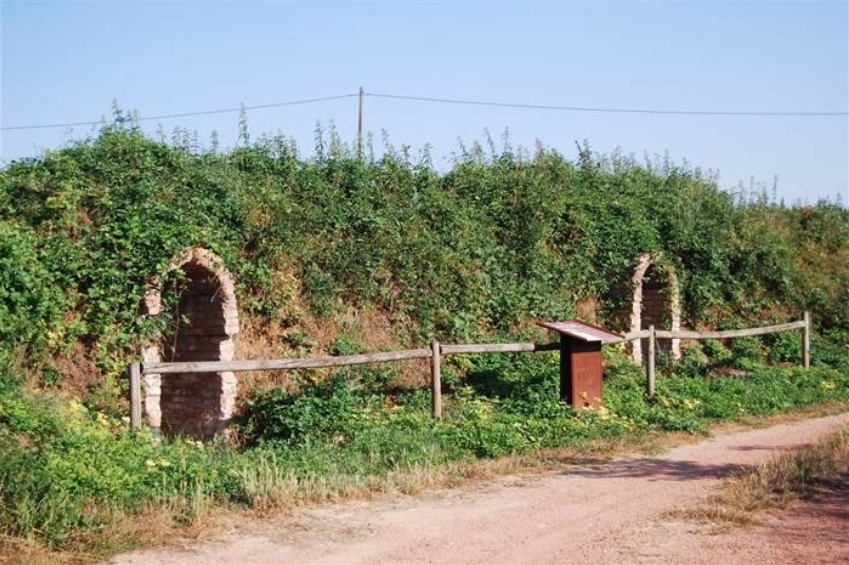Tour of the Shelters of the Santa Eugènia de Berga Aerodrome

The Vilatorta Aerodrome is a prominent point with great historical and tourist importance for the Santa Eugenia de Berga region. The aerodrome was born in 1938 and became a privileged witness to the efforts of the republican government to create a network of defense structures to counter Franco's attacks.
With the aim of creating small fighter-bomber raids, the aerodrome was put into operation to try to stop the latest offensive by national troops on Catalonia.
This former air base from the Civil War currently offers a 9 km hiking route that crosses the municipalities of Sant Julià de Vilatorta, Calldetenes and Santa Eugènia de Berga.
The tour begins at the Sala d'Heures castle, which in the past was the residence of the Government of the Republic during the Civil War. At the beginning of the journey, visitors have the opportunity to see various shelters and structures related to aviation, such as an ammunition store and a hangar. In addition, from the aerodrome you can enjoy an impressive panoramic view of the region.
The Vilatorta aerodrome route is made up of the remains of the old airfield, with a total of 13 shelters, a hangar and a powder magazine.
The route can be done on foot and lasts approximately 2 hours and 40 minutes. It is a unique opportunity to discover the rich history of the area and at the same time enjoy spectacular scenery. The Vilatorta Aerodrome is an ideal place for lovers of history and nature, and it becomes an essential visit for all those who explore Santa Eugènia de Berga. You can also do the route by bicycle and the expected time to do it is 1 hour and 30 minutes at a very easy pace.
It is a flat route, well indicated and easy to do with the family. The shelters are well signposted and some of them are accessible. The setting is gloomy and pleasant to visit.
Race Hangar
Rectangular hangar with dimensions of 23.1 meters wide and 50 meters long. It was built using 15 concrete pillars on each side, which supported a steel structure, and was later covered with a green canvas that formed a semicircular roof. Inside the hangar, the Tupolev SB-2 Ratiusta bombers, of Russian origin, known as Martin Bomber or Sofía by supporters of the Franco regime, were installed.
camp shelter
Each airfield had a field shelter, which had anti-aircraft features and was used to move safely from command to the runway. In this specific case, the refuge had another function: it was located from the Llopart house, which served as the aviation headquarters, to the stream of the same name. Just across the stream was the powder magazine, where bombers' bombs were stored.
lurking house
A small house located on the old road from Calldetenes to Vilalleons, built entirely with stone and covered by two large slabs. At the entrance there is an engraving in 1728. The windows of the building are narrow and long, and due to its location it could have been used as a surveillance or control booth.
the tinderbox
Excavated in the ground of salon, the powder magazine is completely built with concrete. It has a central gallery 22 meters long and four side galleries, two on the left and two on the right, each 10.5 meters long. The galleries are 1.50 meters wide and 2 meters high, with a round roof. Inside it were stored the bombs carried by the bombers that were kept in the Carrera and Casal hangars.
elemental havens
Thirteen basic shelters were built near around the Vilatorta airfield, as well as another one that was dug into the rock. These shelters were strategically located and served as small houses for military surveillance. The density of the oak forest made it possible to keep the planes hidden and under the control of the republican soldiers who guarded them.
The shelters are built of solid brick blocks and all have the same dimensions: two entrances approximately 60 centimeters wide and a transversal corridor 7 meters long, with a width of 80 centimeters and a height of 190 centimeters, with a round roof. The length of the entrances varies depending on the unevenness of the terrain.
You may also be interested in: The Civil War, exile and repression in Catalonia
What to do
Mas Casablanca
Taradell (a 2.3 Km)Mas Casablanca is a traditional peasant house, which is one that provides…
Parc d’Aventura Anigami
L’Esquirol (a 14.3 Km)The Anigami Adventure Park at Mas Les Comes de l'Esquirol is a…
MEV, Museu d'Art Medieval
Vic (a 2.5 Km)Conferences, guided tours, thematic tours, workshops, courses... Discover the permanent collections and…
Where to eat
Braseria Les Comes
L’Esquirol (a 14.3 Km)Located on the premises of the Anigami Adventure Park, they offer menus…
La Calma, el Bellver
Tagamanent (a 16.3 Km)At the Masía Restaurante El Bellver, from 1:00 p.m. to 3:30 p.m.,…
Restaurant Dachs
Les Llosses (a 28.8 Km)Restaurant Dachs offers versatile spaces for celebrations in Les Llosses, with rustic…
Where to sleep
Casa de colònies La Cinglera, Fundesplai
Vilanova de Sau (a 7.5 Km)La Cinglera is located in the Vilanova de Sau municipality. It is…
Hotel Can Pamplona
Vic (a 3.3 Km)Hoel Can Pamplona is a family-run Bed & Breakfast located just steps…
Càmping El Pont de Barcelona
Vilanova de Sau (a 6.4 Km)The El Pont campsite is located in the heart of the Guilleries…
Casa de colònies El Company, Fundesplai
Vilanova de Sau (a 5.8 Km)Discover the El Company hostel, in the municipality of Vilanova de Sau,…





















